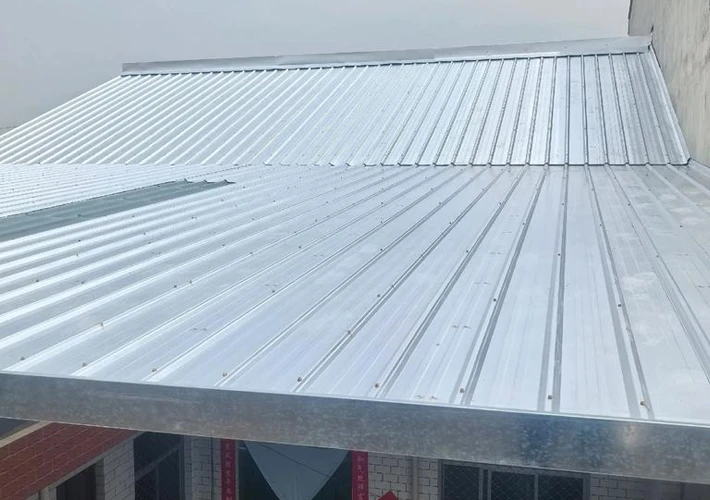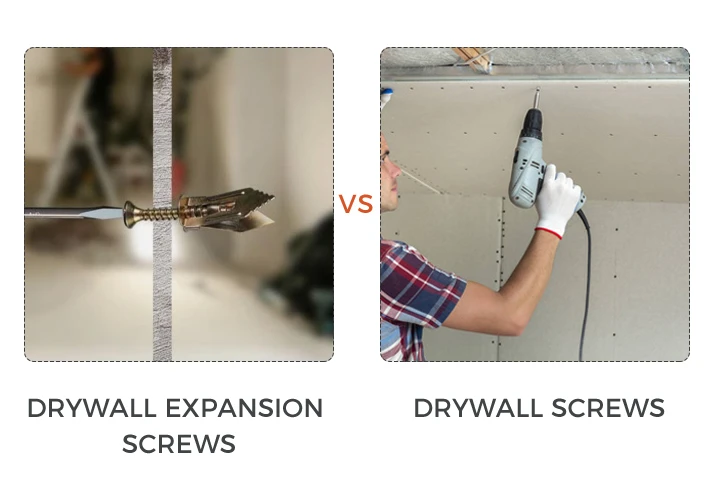Introduction
Nails are among the most fundamental and widely used fasteners in construction and woodworking. Despite their small size, they play a critical role in ensuring the strength, durability, and safety of structures. Among the numerous types of nails available on the market, box nails and common nails are two of the most frequently compared categories. While both serve similar purposes—joining pieces of wood or other materials—they differ in design, application, holding power, and long-term performance.
For builders, contractors, and even DIY hobbyists, choosing the right type of nail can make a significant difference in the quality of the final project. Using the wrong fastener may lead to structural weakness, premature failure, or unnecessary costs. This article provides an in-depth comparison between box nails and common nails, covering everything from their physical differences and applications to their advantages, disadvantages, and suitability for various projects.
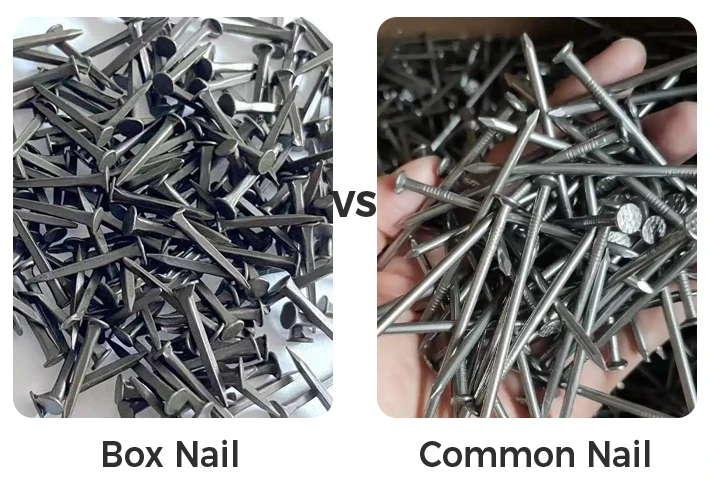
What Are Common Nails?
Common nails are perhaps the most widely recognized type of nail in construction. They are:
- Design: Thick, sturdy, and strong, with a large shank diameter and a flat head.
- Material: Usually made of steel, sometimes coated with zinc for rust resistance.
- Length: Ranges from 1 inch to 6 inches, with the most commonly used sizes being 2–4 inches.
- Strength: Because of their thick shank, common nails provide excellent holding power and resistance to bending.
Typical uses of common nails:
Framing and structural work.
Heavy-duty wood connections.
Exterior construction projects.
Projects where maximum strength is required rather than aesthetic finish.
In summary, common nails are the go-to fastener for heavy-duty wood construction, ensuring strength and durability in structural projects.
What Are Box Nails?
Box nails, while similar in shape to common nails, are designed with specific differences that make them suitable for lighter applications.
- Design: Box nails have a thinner shank diameter compared to common nails but retain a flat head.
- Material: Usually steel, available in coated or galvanized varieties.
- Length: Typically between 1 inch and 3.5 inches, although longer versions exist.
- Strength: Because of their thinner shank, box nails are less likely to split wood but also have reduced holding power compared to common nails.
Typical uses of box nails:
Light wood construction.
Installing siding and trim.
Nailing softwoods or thinner boards.
Applications where preventing wood splitting is more important than maximum stren
Box nails strike a balance between holding ability and material protection, making them ideal for projects involving lighter, thinner, or softer woods.
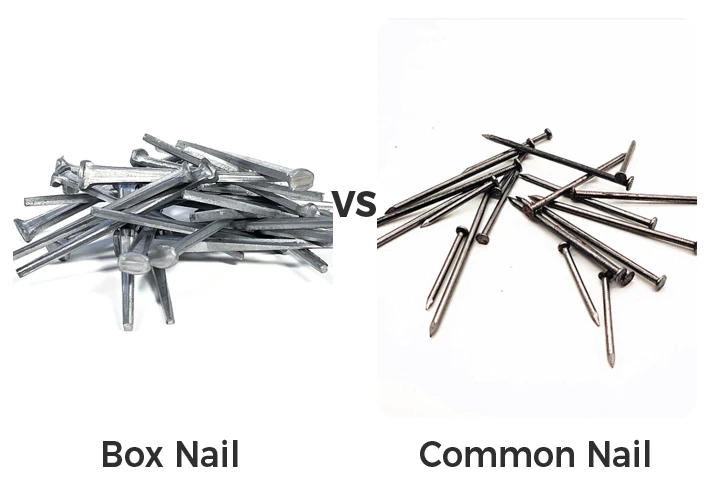
Key Differences Between Box Nails and Common Nails
| Feature | Box Nails | Common Nails |
|---|---|---|
| Shank Diameter | Thinner | Thicker |
| Length Range | 1 – 3.5 inches (standard) | 1 – 6 inches (standard) |
| Holding Power | Moderate | High |
| Wood Splitting | Less likely to split thin wood | Higher chance of splitting wood |
| Strength | Suitable for light-duty applications | Suitable for heavy-duty applications |
| Applications | Trim, siding, small wood projects | Framing, structural projects, exterior |
| Cost | Generally cheaper | Slightly more expensive |
Advantages of Common Nails
Strength and Durability
Common nails are designed for maximum holding power, making them ideal for load-bearing and structural applications.
Versatility
They can be used in a wide variety of construction tasks, from framing to decking.
Wide Availability
Common nails are stocked in almost every hardware store globally.
Longer Sizes
Available in longer lengths, making them suitable for deeper penetration and stronger fastening.
Disadvantages of Common Nails
Risk of Splitting Wood
Because of their thicker shank, common nails can easily split thinner or softer wood.
More Visible
The larger heads are noticeable in finish work, making them less suitable for decorative applications.
Heavier Cost
They tend to be slightly more expensive compared to box nails due to material size.
Advantages of Box Nails
Reduced Risk of Splitting
The thinner shank of box nails minimizes wood splitting, making them ideal for softwood or delicate applications.
Cost-Effective
Generally cheaper than common nails due to their smaller size.
Ease of Use
Easier to drive into wood, especially for lightweight projects.
Neater Finish
The smaller shank leaves less noticeable marks, especially in visible projects like trim and siding.
Disadvantages of Box Nails
Lower Strength
Because they are thinner, box nails have less holding power compared to common nails.
Limited Applications
Not suitable for structural or heavy-duty projects.
Less Variety in Lengths
Box nails are usually available in shorter lengths compared to common nails.
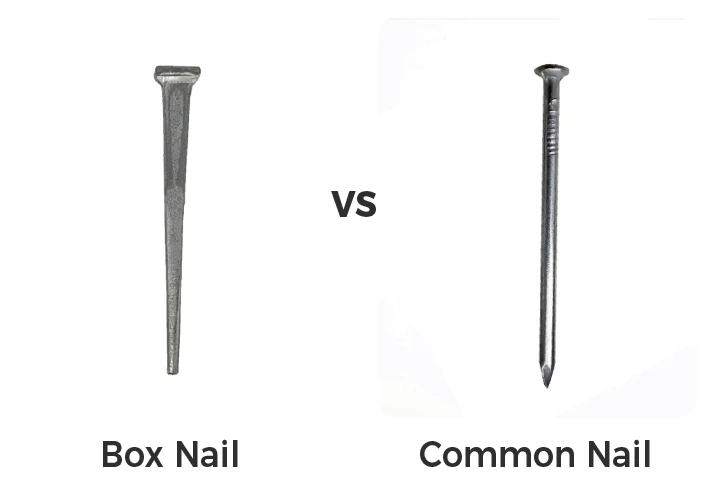
Applications in Construction and Carpentry
Common Nail Applications:
- Framing walls and roofing.
- Building wooden crates, pallets, and other heavy-duty wooden structures.
- Deck building and outdoor structural work.
- Large furniture construction requiring strength.
Box Nail Applications:
- Installing siding, sheathing, and trim.
- Cabinet making and small furniture assembly.
- Craftwork or DIY projects with thin boards.
- Situations where wood splitting needs to be avoided.
Box Nail vs Common Nail in DIY Projects
For DIY enthusiasts, the choice between box nails and common nails depends largely on the type of project:
- Building a wooden shelf? Common nails will provide the required strength.
- Attaching thin trim or molding? Box nails are better to prevent cracking or splitting.
- Outdoor garden projects? Galvanized common nails are preferred for durability.
- Indoor lightweight crafts? Box nails are easier to handle and cost-effective.
Materials and Coatings Available
Both box nails and common nails are manufactured in several finishes:
Bright (uncoated) – Best for indoor applications where rust isn’t an issue.
Galvanized – Coated with zinc for corrosion resistance, ideal for outdoor use.
Vinyl-Coated – Designed for easier driving into wood with added holding power.
Stainless Steel – Premium corrosion resistance, commonly used in marine or high-humidity environments.
Cost Comparison
Box nails are generally cheaper due to less material being used.
Common nails cost slightly more but provide stronger holding, reducing the risk of rework or failure.
For large-scale construction, the difference in cost becomes negligible compared to the overall project budget. However, for small DIY projects, box nails are often the economical choice.
Safety Considerations
- Always wear protective eyewear when hammering nails.
- For common nails (which require more force to drive), ensure proper hammer control to prevent accidents.
- In projects involving thin wood, forcing common nails may split the material, creating safety hazards later.
Environmental Considerations
Material efficiency: Box nails use less steel, making them slightly more resource-efficient.
Longevity: Common nails, especially galvanized or stainless steel, last longer in outdoor conditions, reducing replacement frequency.
Recyclability: Both are recyclable, as most are made of steel.
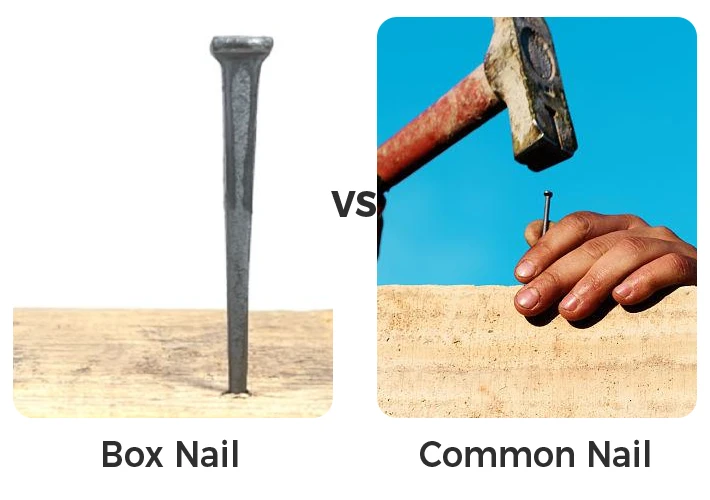
Which One Should You Choose?
Choose Common Nails If:
- You are building structural or load-bearing projects.
- You require maximum holding power.
- You are working with hardwoods or large lumber.
Choose Box Nails If:
- You are working with softwood or thinner boards.
- You want to minimize wood splitting.
- You are doing lightweight projects like trim, siding, or indoor carpentry.
Conclusion
While both box nails and common nails are widely used in woodworking and construction, the choice depends on the specific requirements of the project. Common nails are stronger and more durable, making them the preferred option for structural work and heavy-duty applications. Box nails, on the other hand, are thinner and less likely to split wood, making them suitable for lighter, more delicate work such as trim and siding.
In the end, neither type is “better” than the other; rather, each serves a different purpose. For contractors and DIY enthusiasts, understanding when and where to use each type ensures not only the structural integrity of the project but also cost efficiency and long-term durability.

